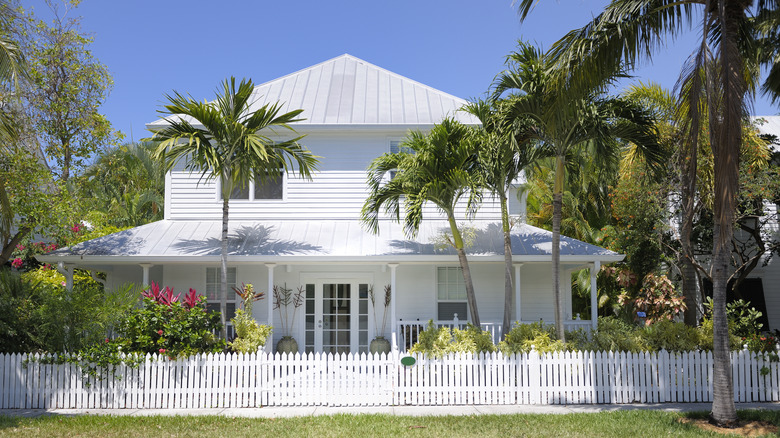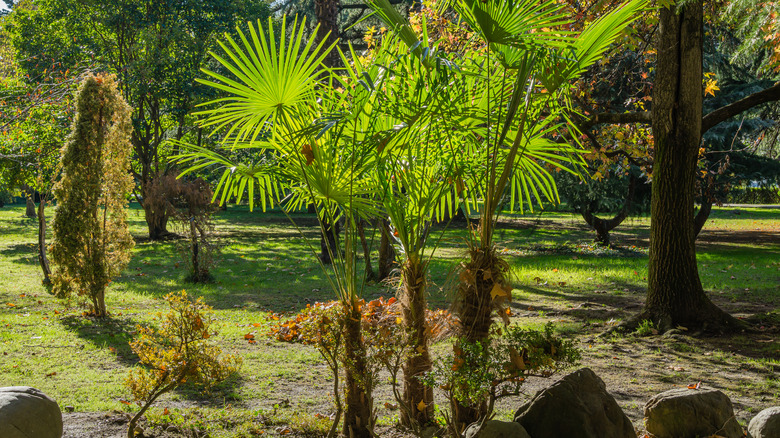The Beautiful Palm Tree That'll Survive In Damp Soil And Colder Environments
Given their quintessential association with sun-drenched tropical environments, palm trees are often precluded from the planting options available to those in colder zones. But windmill palm (Trachycarpus fortunei) trees, with majestic, 3-foot wide palmate fronds that spiral out like a fan, are an exception. These broadleaf evergreens tolerate temperature dips to 10 degrees Fahrenheit, making them the most cold-hardy specimen among their trunked cousins. While suitable in USDA zones 7 to 10, they need protection or to be overwintered indoors if grown in containers in particularly chilly winters.
Windmill palms, also called chusan palms, are native to the mountain forests of China and are highly adaptable to most soils, from acidic to alkaline. Another advantage is that they thrive in naturally damp soils, which explains their popularity in yards along the coasts. However, one caveat is that the planting medium must remain moist without turning squelchy, or they may contract root rot. While these cold-tolerant tropical plants don't attract pollinators, they add wildlife value by sheltering shade-seeking mammals — though deer generally stay away.
Site selection for windmill palms
Besides the fan-like foliage, windmill palm's attractiveness is attributable to its 12-inch wide, brown trunk overlaid with black, burlap-like, fibrous growth. These hair fibers are remnants of old leafy growth, lending the tree much-needed protection from cold temperatures. The dark black-brown shade helps, as it traps the sun's heat, assuming it graces the site. These trees are at their best in partially or fully shaded areas, given their need for moisture. They'll tolerate some sun but must be supplemented with irrigation. Another reason for these Chinese natives becoming winter hardy is their slow growth rate. They gain a maximum of 8 inches in a year, redirecting their resources to below-ground growth and building up climate acclimation mechanisms.
Windmill palm trees share a penchant for moist, well-draining soils. So, if waterlogging is a concern, mix sand and dirt in a 1:4 ratio into the soil before planting them. Sticking to a weekly irrigation schedule once the trees have become established should stave off any trouble. Just avoid growing them in windy or frosty areas, as the leaves may tear under the pressure.
Using windmill palms in the landscape
Although windmill palm trees can top out at 25 feet, in non-wild areas, they will reach about 10 feet at maturity, making them an excellent small palm tree option for yards where space is at a premium — the slow growth helps, too. Besides, they span only 6 to 10 feet wide without plastering the ground below with flower and fruit litter. Plus, the roots pose no major threat, making them safe in tight backyard areas. Pruning isn't a huge priority unless you want to remove the dead leaves to maintain a neat look.
In bigger yards, several trees can be planted to create a tropical grove. This is usually achieved by planting three or more trees and spacing them 6 to 10 feet apart. Alternatively, you can follow the same arrangement to frame the entrance or borders of a rock, water, or English garden or to highlight a patio. They can also be layered with companion plants like the African lily, Black-eyed Susan, castor oil plant, bird of paradise, hibiscus, and jatropha. Consider growing them in containers to shield them indoors when required in icy areas. However, remember, while windmill palms aren't considered invasive, they pose a slight risk, as they propagate via seed. Fortunately, the trees are dioecious, meaning they require both male and female plants to produce seeds, making the occurrence of spreading rare.


